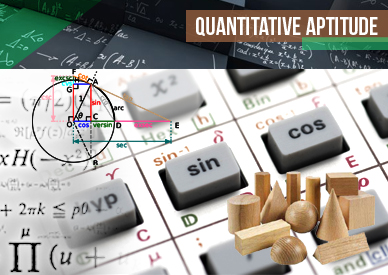Crack IBPS PO : Algebra New Pattern Questions : Day 43
Want to Become a Bank, Central / State Govt Officer in 2020?
Join the Most awarded Coaching Institute & Get your Dream Job


Now Prepare for Bank, SSC Exams from Home. Join Online Coure @ lowest fee
Lifetime validity Bank Exam Coaching | Bank PO / Clerk Coaching | Bank SO Exam Coaching | All-in-One SSC Exam Coaching | RRB Railway Exam Coaching | TNPSC Exam Coaching | KPSC Exam Coaching
Crack IBPS PO : Algebra New Pattern Questions : Day 43
Directions: 1-5) Read the following information and answer the questions accordingly.
Q.1) Quantity I: By selling 20 mangoes for Rs.520 a total profit of Rs. 40 is obtained. What is the cost price of one mango?
Quantity II: Total market price of 15 mangoes Rs.500 which was Rs.50 more than the total cost. What is the cost price of one mango?
a)Quantity I<Quantity II
b) Quantity I>Quantity II
c) Quantity I≤ Quantity II
d) Quantity I≥ Quantity II
e) Quantity I= Quantity II
Q.2)
Quantity I : A person marked the price of a refrigerator 60% above the cost price. By giving a discount of 25% the seller sold the refrigerator at the price of Rs.15000 . what is the cost price of the refrigerator?
Quantity II: The cost price of a refrigerator is Rs.7500, which is sold at a profit of 60%. What is the selling price of the refrigerator?
a) Quantity I< Quantity II
b) Quantity I> Quantity II
c) Quantity I≤ Quantity II
d) Quantity I≥ Quantity II
e) Quantity I= Quantity II
Q.3)
Quantity I: Find the average of all the numbers between 1 to 50 that are prime numbers?
Quantity II: Find the average of first 20 natural numbers?
a) Quantity I< Quantity II
b) Quantity I> Quantity II
c) Quantity I≤ Quantity II
d) Quantity I≥ Quantity II
e) Quantity I= Quantity II
Q.4)
Quantity I: Pipe A can fill the tank in 40 hours, when it works at 60% of their efficiency. Pipe B is one third as efficient as pipe A. How long will it take if both the pipes operate simultaneously at the 100% efficiency.
Quantity II: 18 hours.
a) Quantity I< Quantity II
b) Quantity I> Quantity II
c) Quantity I≤ Quantity II
d) Quantity I≥ Quantity II
e) Quantity I= Quantity II
Q.5)
What is the rate of interest per annum?
Quantity I : The difference between the compound interest and the simple interest accrued on an amount of Rs.50000 at the end of two years is Rs .320
Quantity II: The simple interest after three years for Rs.50000 is Rs.12000
a) Quantity I< Quantity II
b) Quantity I> Quantity II
c) Quantity I≤ Quantity II
d) Quantity I≥ Quantity II
e) Quantity I= Quantity II
Q.6)Mohan distributed his assets to his wife , four sons, three daughters and six grand children in such a way that each grand child got one-sixteenth of each son and one-tenth of each daughter. His wife got 60% of the total share of his sons and daughter together. If each daughter receives assets of worth Rs.1.25 lakh, what is the share of his wife?
a)Rs. 705000
b)Rs.815000
c) Rs.750000
d) Rs.835000
e) None of these
Q.7) There are 3 inlet pipes X, Y and Z connected to a tank. If only one pipe is opened at a time, then it takes 50, 40 and 25 minutes for pipes X, Y and Z respectively to fill the tank. Find the time taken to fill 99% of the tank if it is known that in every 5 minutes for the first 2 minutes pipe Y is opened and then closed for 3 minutes. The remaining pipes are always kept open.
a) 14 minutes
b) 16 minutes
c) 18 minutes
d) 20 minutes
e) Cannot be determined
Q.8) A certain number of people get together to contribute in the construction of a charity hospital. But every month four people step out of this plan. Due to this the task is completed in half more year instead of one year. Then how many people were originally involved in this plan?
a) 153
b) 95
c) 102
d) Cannot be determined
e) None of these.
Q.9) Find the percentage by which the volume of the circular cylinder change assuming that the radius and the height of the circular cylinder decreases by 20%?
a) 48.8%
b) 46.7%
c) 57.7%
d) 65%
e) None of these
Q.10) A cyclist, cycling on a road, passes a man who was walking at the rate of 4 km/hr in the same direction. The man could see the cycle for 12 min and it was visible to him up to a distance of 1.2 km. What was the speed of the cycle?
A) 10 km/hr
b) 12km/hr
c) 6 km/hr
d) Cannot be determined
e) None of these
Coding Decoding New Pattern Questions




2 comments
Please explain 4th one
For quantity I, Answer is 18 hours.
Quantity II is 18 hours
So both quantities are equal.
So answer is E